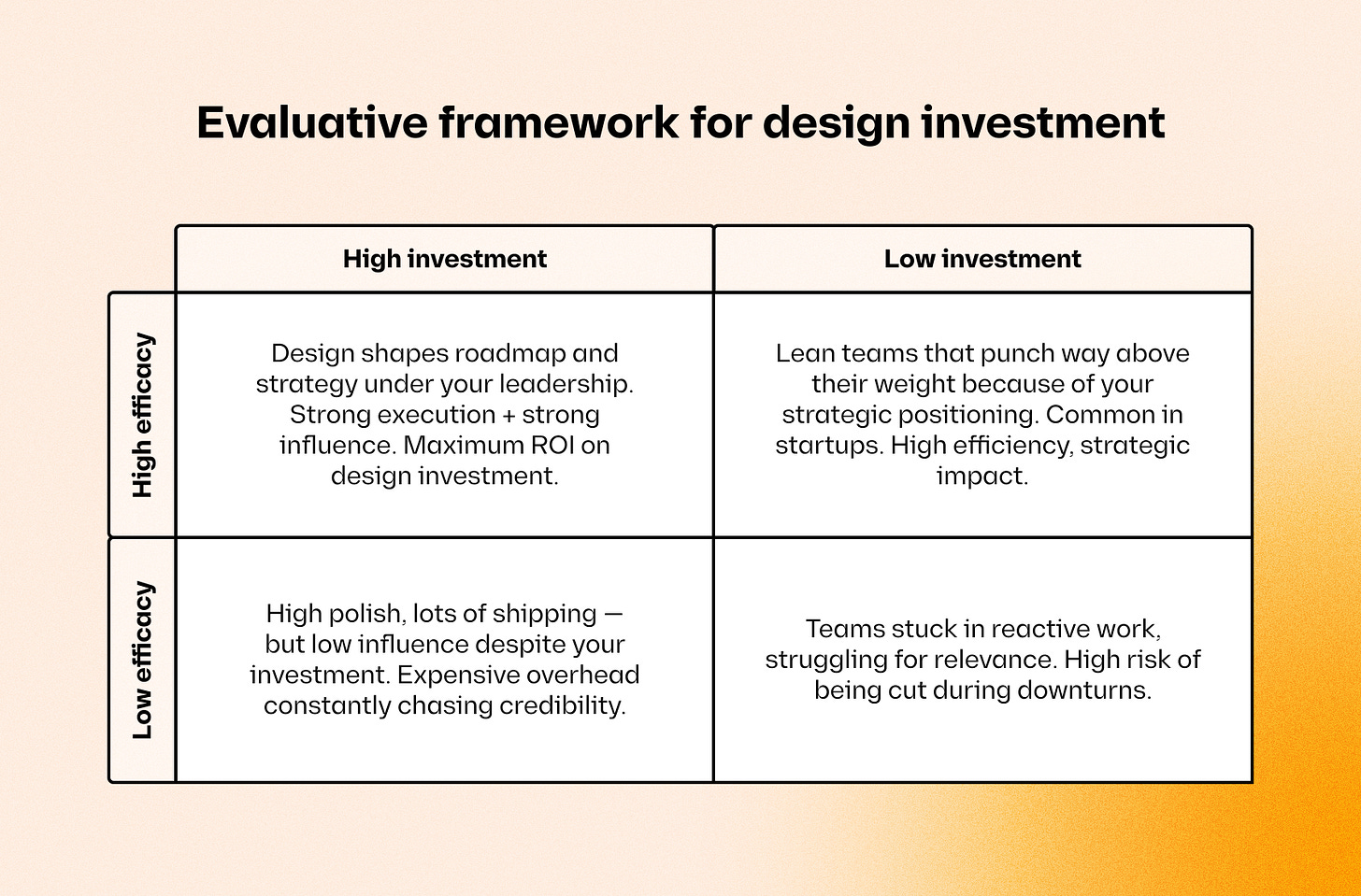Issue 15: What does design maturity actually mean?
How to audit and improve your design team's impact
Design maturity has become the holy grail for design leaders. It's the idea that as organizations grow, their design capabilities should evolve from basic execution to strategic influence—moving from "make it look good" to "help us build the right thing."
But here's the problem: Most organizations measure design maturity completely wrong. They focus on operational improvements: expanding design teams, implementing processes, securing leadership representation—while missing what actually creates strategic impact.
Check those boxes and you’re done, right?
Your team has reached some irreversible, mythical level of design maturity.
The reality: Teams can achieve all traditional maturity markers while remaining strategically irrelevant.
Real maturity isn't about how many designers you have or whether you're in the room when decisions get made. It's about whether you can actually change the trajectory of the product and business.
This comes down to understanding two fundamental dimensions: Adoption (how much your organization invests in design) and Efficacy (whether your work actually shapes outcomes).
Most leaders obsess over the first dimension and completely ignore the second. The best ones build systems that deliver both.
1. Adoption: How much your org is willing to invest in design
Adoption reflects organizational willingness to invest in design and research functions—the obvious operational markers:
Are you funded for the right tools and team investment?
Is headcount growing alongside the company?
Is design represented in roadmap and strategy conversations?
Many teams stop here. If you've got decent budget and meeting invitations, it feels like maturity. You might even have design ops rituals and a strong research function.
Its understandable because it takes a lot to achieve the above and even more effort to maintain it.
But adoption alone doesn't mean impact.
You can have high investment and still see low impact. Dozens of designers might ship mockups daily, research may have in-depth share-outs while having almost no influence over product direction. The culture becomes top-down and reactive, burning through budget with incremental gain (which may not always be a bad thing, but if there’s room to do better than why not?).
Meanwhile, scrappy startup teams with two to three designers can become some of the most influential voices in the company, directly impacting growth and strategy.
Resource investment is just one piece of the puzzle—it doesn't tell the full story about return on design investment.
2. Efficacy: How much your design work actually matters
The other piece—and honestly, the more important one for your business—is efficacy.
Efficacy measures how much your design team's work actually matters to organizational success:
Are you enabling them to influence what gets built?
Are you positioning them to shape strategy early, not just execute after decisions are made?
Are you helping them connect their work clearly to measurable business outcomes?
Without leadership creating efficacy, teams get stuck in triage mode—constantly reacting to requests, measuring success by output volume, optimizing for efficiency over influence.
High-efficacy teams operate differently
They're in the room before decisions get made because you've secured their access. They shape your roadmap because you've empowered them to contribute. They know when and where to intervene because you've given them strategic context.
Most importantly, their contributions show up in your growth metrics, conversion rates, and product direction because you've connected their work to business outcomes.
A strategic framework for design investment
If you want to understand where your design organization really stands, evaluate both dimensions:
Organizations move across these quadrants constantly due to leadership changes, market dynamics, business focus shifts, and economic pressures. But the key insight is: Maturity isn't about headcount. It's about your ability to create impact through your team.
Teams with strong efficacy can adapt, pivot, and thrive—even under resource constraints—because you've built their strategic value. Their worth isn't defined by size or output, but by influence and strategic contribution. This creates organizational resilience.
Leading in leaner times
Right now, design teams are being challenged to operate leaner and faster. This is especially difficult for leaders who equated maturity with scale.
Many teams are being asked to do more with less, blurring lines of ownership and responsibility. If your team is thriving in this environment, that's a strong signal you've built high efficacy. But if their roles are becoming overly specialized or narrowed, it's a warning sign that key decisions are being made without design input—and critically, without your voice advocating for design's role.
This is a critical moment to assess: Are you losing influence, and by extension, is your team losing relevance?
Your action plan
As a leader, don't get caught chasing headcount ratios and resource benchmarks—those can all change during the next budget cycle.
Instead, focus on building efficacy through your leadership. But here's the key: you need to be in the room first. Your team can't influence decisions they don't know about, and they can't attend meetings you're not invited to yourself.
This week:
Audit your own meeting access - Are you in the room for strategic planning, roadmap setting, and budget discussions? If not, your design team has no chance of being upstream.
Review your last 3 major product decisions - How many included design input before the direction was set? If it's less than 2, you failed to position your team properly.
Ask your design lead for their top 3 business concerns - Not design concerns, business concerns. If they can't articulate them, it's because you haven't given them visibility into what you're seeing.
Next 30 days:
Get yourself included in higher-level strategic conversations - If you're not in the room for executive planning, your design team will always be playing catch-up.
Connect one design project to a business metric - Pick your most important current design initiative and define how you'll measure its business impact.
Share executive context with your designers - What business pressures are you hearing about? What's keeping other department heads up at night?
This quarter:
Establish design KPIs that matter to executives - Move beyond "shipped designs" to metrics like conversion improvement, user satisfaction, or feature adoption. If you don’t have access to these types of dashboards then it may be time to prioritize this instead!
Create a design roadmap tied to business goals - If your design team doesn't have visibility into next quarter's business priorities, first ask yourself: do you have that visibility?
Position yourself as the design advocate in leadership - When strategic decisions are being made, you need to be the voice asking "What's the impact on the design team" before it gets to your team.
Real design maturity isn't about being seen or having the biggest team. It's about your ability as a leader to create measurable impact through your design organization.
The question isn't whether you can afford to invest in design. It's whether you can afford not to develop your leadership skills and lean-in to maximize that investment.
Technically Speaking is where I share reflections, insights, and conversations to help you lead with confidence, clarity, and community. Are you looking to level up your design leadership and management craft? Spend an hour with me for personalized 1:1 coaching to help you thrive in your role.




